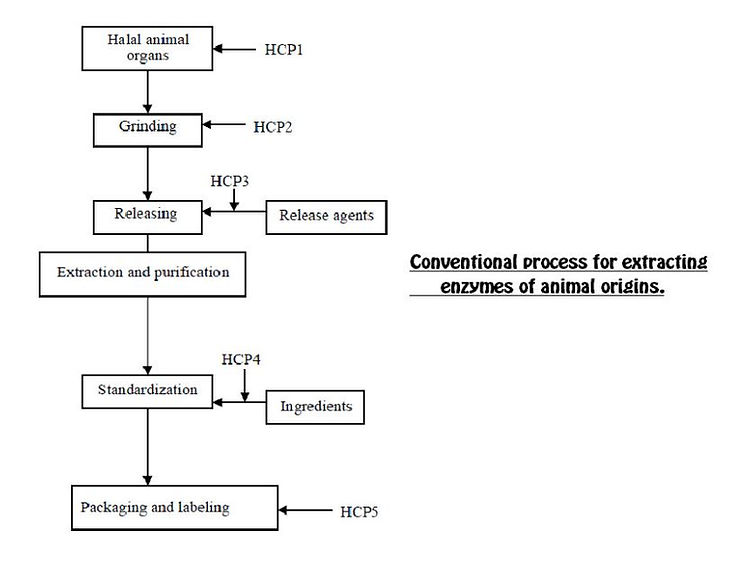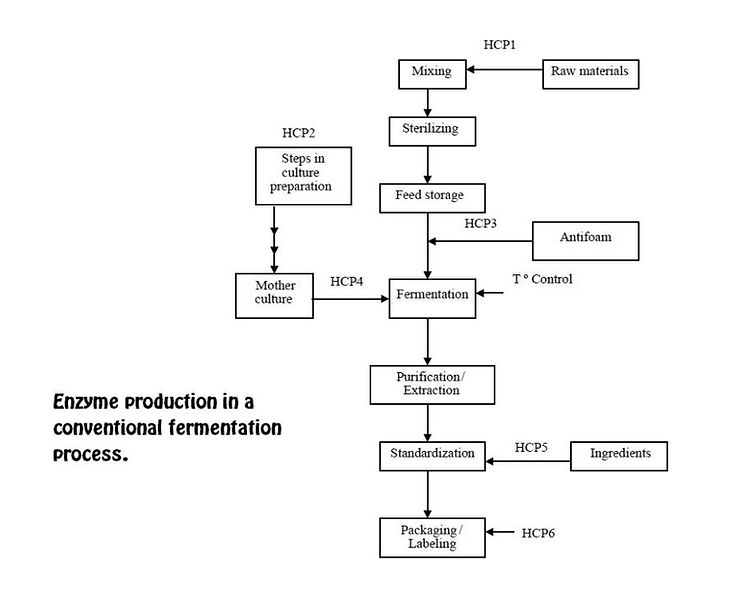The International Union of Biochemists has developed an identification system to classify enzymes. Naming of enzymes involves a numerical classification, a long systematic name, and a short, easy-to-use name. For example, the enzyme that catalyzes the conversion of lactose (milk sugar) to galactose and glucose is classified as EC 3.2.1.23, has the systematic name â-D-galactoside galactohydrolase, and the common name lactase. Enzymes are classified into six categories:
Oxidoreductases — catalyze oxidation reactions, such as the conversion of alcohol.
Transferases — enzymes that catalyze the transfer of a group of atoms, referred to as a radical, from one molecule to another, such as the transfer of amino groups.
Hydrolases — catalyze the reaction of a chemical with water. This usually breaks up large molecules into smaller ones, such as the hydrolysis of proteins.
Lyases — catalyze reactions producing or resulting in double bonds, for example, conversion of sugars.
Isomerases — catalyze the transfer of groups on the same molecule, resulting in a new structure for the molecule.
Ligases — enzymes catalyze the joining of molecules to form larger molecules.
The identification and understanding of DNA led to gene splicing and the development of bio-engineered enzymes. Many enzymes are now produced by bio-engineering, with a variety of methods employed for growth and production of enzymes. One method of production is submerged fermentation. In this process, selected microorganisms (bacteria and fungi) are grown in closed vessels in the presence of liquid nutrients and oxygen. As the microorganisms break down the nutrients, they release enzymes into the solution. The nutrients are normally sterilized foodstuff such as cornstarch, sugars, and soybean grits. The process can be operated continuously or in a batch mode. Temperature of the vessels and oxygen consumption and pH are carefully controlled to optimize enzyme production.
Recovering the enzymes, referred to as harvesting, is done in a number of steps. First, the solids, referred to as biomass, are removed by filtration or centrifugation. The enzyme remains in the solution, called the broth. The broth is evaporated to concentrate the enzymes. The enzymes can be further purified by ion exchange, before further processing into powders, liquids, or granules. The residual biomassis stabilized by lime treatment and used as fertilizer.

HALAL CONTROL POINTS IN ENZYME PRODUCTION
Enzymes are harvested or extracted from natural biological sources such as animal tissues, plant materials, or microbial sources. Enzymes can also be produced through a fermentation process. Requirements for each process are quite different and unique to each product. Therefore, HCPs have been determined keeping the uniqueness of the processes in mind.

HALAL CONTROL POINTS FOR A CONVENTIONAL PROCESS FOR EXTRACTING ENZYMES FROM ANIMAL ORGANS
There are five HCPs: use of halal organs, clean equipment, acceptable release agents, approved standardization ingredients, and proper packing and labelling.
HCP1: Animal Organs
In commercial practice, enzymes are extracted from many animal organs of various species such as porcine, bovine, or ovine. Enzymes extracted from pig organs are not acceptable by any halal consumer or regulatory group, so these must not be used individually or in combination with other animal organs. Organs should be
from halal-slaughtered animals to be universally acceptable. Such organs might have to be harvested from regions where Muslims perform animal slaughter. Some countries might accept enzymes from halal animals even though the animals are not slaughtered by Muslims.
HCP2: Preparation of Tissues for Extraction
Because a majority of the enzymes of animal origin are from non-halal sources, use of common equipment presents a hazard. Before using the equipment for extracting halal enzymes, it must be thoroughly cleaned to avoid contamination from previous runs.
HCP3
Enzymes might not be present in the tissues in soluble form and therefore need to be released or made soluble to increase the yield. Chemicals used for this purpose must be suitable for halal production.

HALAL CONTROL POINTS FOR A CONVENTIONAL PROCESS FOR EXTRACTING ENZYMES FROM ANIMAL ORGANS
There are five HCPs: use of halal organs, clean equipment, acceptable release agents, approved standardization ingredients, and proper packing and labelling.
HCP1: Animal Organs
In commercial practice, enzymes are extracted from many animal organs of various species such as porcine, bovine, or ovine. Enzymes extracted from pig organs are not acceptable by any halal consumer or regulatory group, so these must not be used individually or in combination with other animal organs. Organs should be
from halal-slaughtered animals to be universally acceptable. Such organs might have to be harvested from regions where Muslims perform animal slaughter. Some countries might accept enzymes from halal animals even though the animals are not slaughtered by Muslims.
HCP2: Preparation of Tissues for Extraction
Because a majority of the enzymes of animal origin are from non-halal sources, use of common equipment presents a hazard. Before using the equipment for extracting halal enzymes, it must be thoroughly cleaned to avoid contamination from previous runs.
HCP3
Enzymes might not be present in the tissues in soluble form and therefore need to be released or made soluble to increase the yield. Chemicals used for this purpose must be suitable for halal production.




